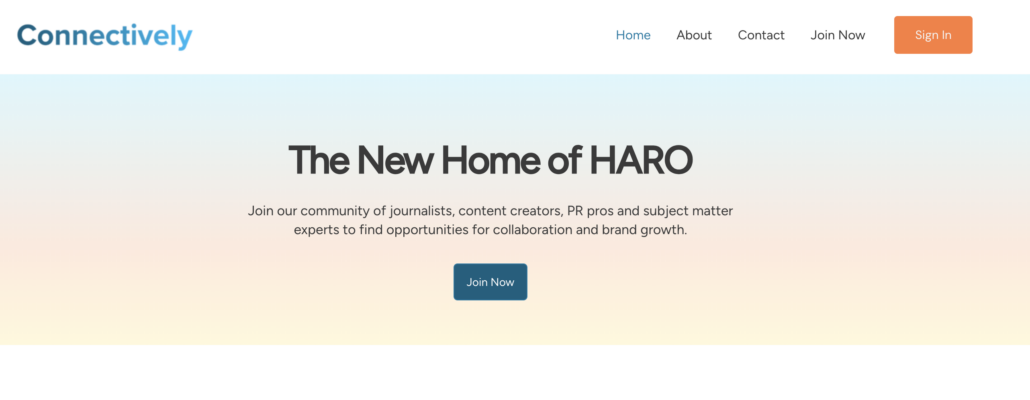Mastering Media Exposure: Leveraging Press Opportunities with HARO
by Stacey Bender
Bender Group highly values HARO, a powerful platform facilitating seamless connections with journalists actively seeking insights. Operating under the acronym “Help A Reporter Out,” HARO acts as a bridge between journalists and sources, enabling strategic engagement. By utilizing HARO’s press request service, individuals establish contact with journalists seeking information, leading to mutually beneficial exchanges. This approach has not only secured backlinks from authoritative websites but has also garnered significant press mentions. Whether launching a new venture or managing an established business, leveraging diverse approaches such as HARO within comprehensive strategies like SEO, PPC, and social media proves instrumental in boosting visibility and strengthening SEO through valuable backlinks.
How to Apply for HARO: A Step-by-Step Guide
Effectively navigating HARO mirrors the experience of exploring a dynamic marketplace, where journalists and sources occupy distinct sides. The journey commences by creating a ‘source’ account on HelpAReporter.com. To establish your HARO account, visit the HARO website and initiate the profile creation process. Furnish essential details, including your name, email address, and fundamental information about your expertise and industry.

Upon registration, you’ll be guided to designate your areas of expertise, ensuring that HARO channels requests exclusively within your chosen topics. The subsequent step involves configuring your HARO preferences. After registration, you will receive emails three times a day, Monday to Friday, encompassing all ongoing source requests. These emails are conveniently labeled as “Morning,” “Afternoon,” and “Evening” editions.
To initiate your HARO account, visit the HARO website and construct your profile. Share crucial details, including your name, email address, and insights about your expertise and industry.
Moreover, tailor your preferences to align with your specific area of expertise, specifying the frequency of email notifications. This customization guarantees that you remain well-informed and connected with pertinent opportunities.
Optimizing HARO for Press Success: Our Methodology
Guided by comprehensive keyword research and specific target terms, our methodology revolves around pinpointing optimal press requests that align with our selected topics. It’s crucial to acknowledge that there’s no assurance of finding an opportunity that perfectly matches our criteria. Nevertheless, we integrate this uncertainty into our strategy, maintaining adaptability in the terms and publications we pursue. Throughout the week, I regularly check HARO, swiftly scanning to avoid overlooking time-sensitive opportunities that align with my ongoing campaigns. Typically, I carve out dedicated time in my weekly schedule for research and pitching, enabling me to focus entirely on crafting impactful pitches. When immersed in the pitching process, I adhere to specific guidelines:
- Personalize the pitch by addressing the reporter by name, when available.
- Introduce myself succinctly, providing a brief one-line bio or highlighting relevant credentials.
- Present a concise summary of my insights on the subject, preferably in bullet points (4-8 lines).
- Offer 3-4 communication channels (email, Skype, WhatsApp, etc.) to facilitate seamless contact for any additional queries from the journalist.

Strategies for Effective Backlinking and PR Success
1. Evaluate the Media Outlet’s Domain Rating:
The domain rating, or domain authority, reflects your website’s SEO value. Assessing the media outlet’s DR is crucial when building backlinks. A higher DR of the backlink source contributes to improving your own. Checking the DR of the media outlet helps determine if pitching to the journalist is worthwhile.
2. Selectively Respond to Relevant Queries:
Given the multitude of HARO queries daily, respond only to those aligning with your expertise and experience. Relevance is integral to Google’s E-A-T formula. Tailor your response to match the journalist’s requirements, showcasing your suitability for the query.
3. Highlight Your Credentials:
Establish your credibility immediately by showcasing your credentials and relevant experience. Clearly communicate that you are a reliable and credible source. Remember, significant credibility can be impactful, and you don’t need to be a notable figure to secure media coverage.
4. Swift Responses Matter:
Journalists operate under tight deadlines, making proactive responses essential. Attempt to be the first to respond, ideally within 30 minutes. Journalists value efficiency, so provide quick and concise responses, meeting their need for convenience.
5. Quantify or Quote Your Input:
Support your input with case studies and statistics to enhance credibility. Quantifiable data and quotable excerpts make your responses more compelling. Visualize how your response would fit into an article, ensuring clarity and conciseness.
6. Exercise Restraint in Follow-ups:
Avoid excessive follow-ups if you don’t receive a response. Persistent chasing may convey desperation. Journalists prioritize qualified and timely pitches, and persistent follow-ups can be counterproductive.
7. Manage Expectations:
Recognize that not every pitch will succeed on HARO. A success rate of 5-10% is common, and even specialists may not achieve success with every pitch. Maintain a positive and consistent approach, understanding that success is about quality, not quantity.
8. Cultivate Relationships:
View HARO as a two-way street focused on building relationships, not just acquiring backlinks. Share articles within your network, express gratitude to journalists, and offer assistance with future articles. Building genuine relationships enhances your long-term success.
9. Monitor Your Achievements:
Track the success of your HARO efforts through a spreadsheet, noting the publication name and outcomes. Recognize that not all links carry equal weight, considering context, relevance, and authority in determining ranking power. Track and analyze your successes to refine your approach over time.
Conclusion: Maximizing Efficiency for Lasting Success
For everyone, and particularly in the entrepreneurial realm, time equates to currency. Maximizing efficiency—saving time, resources, budget, and effort while still achieving favorable outcomes—is paramount. Concentrating on a singular link-building strategy proved immensely effective for us. By prioritizing passive link building exclusively through HARO, significant results were attained. Notably, this approach allowed me to bypass various other methods and streamline my efforts. The centralized dashboard on HARO became a time-saving asset, eliminating the need to sift through numerous HARO emails inundating my mailbox.
Welcome Stranger! This is an example Text for your fantastic Promo Box! Feel Free to delete it and replace it with your own fancy Message!
About Us
The Bender Group is a boutique public relations firm that combines the strongest elements of traditional PR with innovative techniques to consistently secure top-tier media placement for our clients.